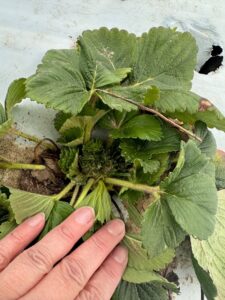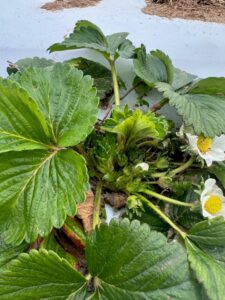We are concerned about frost/freeze damage to the crops at this time of year. As I am writing this article, we had forecasted low temperatures in the lower 20sºF on March 14 and 18 in southern Indiana. How does this affect plasticulture strawberries? I want to share my thoughts in this article.
Before discussing whether the temperatures cause damage to strawberries, I want to update the cultivar ‘Chandler’ status at two fields at Southwest Purdue Ag Center. In one area, we occasionally saw tight buds. Flower clusters of the majority of the plants have not grown out of the crowns yet (Figure 1). In the second field, one or two open blooms appear on some plants (Figure 2), and more plants have popcorn-stage and tight buds compared to the first field.
Why did the two adjacent fields differ slightly in crop growth stages? While other factors could play a role, the date we removed the row covers that covered the plants for the winter might have contributed to this difference. The row cover was removed on Feb. 20 in the first field and Feb. 28 in the second field. Eight days may not seem significant, but a few of those days had temperatures above 60ºF. Relatively warm temperatures in Feb. and coverage with row covers could have stimulated plant growth in the second field.
Let’s review the temperature thresholds of cold damage in the different stages of flowering. Typically, open strawberry flowers can not tolerate temperatures lower than 32°F. Popcorn stage flowers and tight buds may take temperatures low to 26 and 22°F, respectively. whether we should consider pulling row covers back to protect the crops? Without any protection, we would lose open flowers and maybe popcorn-stage flowers in the coming days with low temperatures down to lower 20ºF. Tight buds and flower clusters still in the crown will survive. That said, I do not think pulling row covers back in the first field is necessary.
Pulling row covers back in the second field might save the popcorn-stage flowers, even open flowers. But the question is whether saving the early flowers can compensate for the labor of pulling row covers back and forth. Another thought is that we are far away from frost-free dates. Even if the early blooms survived the current frosts, they might not develop into marketable fruit as there are still high chances of frosts in April. When they enter full bloom, hard frosts will be more detrimental to strawberry crops. Preventing plants from entering full bloom too early would reduce the risk, even though we cannot predict when and whether we will have hard frosts in April.
With that said, I don’t think it is necessary to pull row covers back for frost protection now. If saving the early blooms is desirable, consider covering the crops on the coldest nights and uncovering the crops immediately after the temperature returns to above freezing. Do not cover the plants for an extended period; that may stimulate the growth and make plants enter full bloom too early, which might increase the risk of severe frost damage later in the season.
Below are a few articles I wrote on this topic. It might remind us of what happened in previous years.
2020: Strawberry growers should be prepared for cold protection Strawberry cold protection made a difference
2021: Strawberry frost protection

